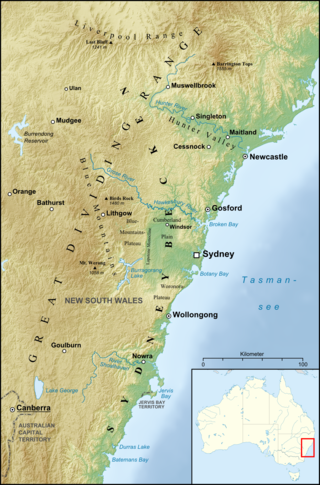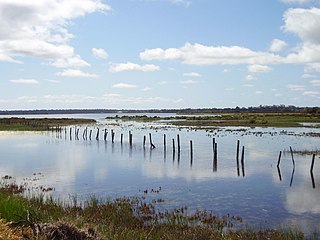Related Research Articles

Bangladesh is a densely populated, low-lying, mainly riverine country located in South Asia with a coastline of 580 km (360 mi) on the northern littoral of the Bay of Bengal. The delta plain of the Ganges (Padma), Brahmaputra (Jamuna), and Meghna Rivers and their tributaries occupy 79 percent of the country. Four uplifted blocks occupy 9 percent and steep hill ranges up to approximately 1,000 metres (3,300 ft) high occupy 12 percent in the southeast and in the northeast. Straddling the Tropic of Cancer, Bangladesh has a tropical monsoon climate characterised by heavy seasonal rainfall, high temperatures, and high humidity. Natural disasters such as floods and cyclones accompanied by storm surges periodically affect the country. Most of the country is intensively farmed, with rice the main crop, grown in three seasons. Rapid urbanisation is taking place with associated industrial and commercial development. Exports of garments and shrimp plus remittances from Bangladeshis working abroad provide the country's three main sources of foreign exchange income.

Lake Illawarra is an open and trained intermediate wave dominated barrier estuary or large coastal lagoon, is located in the Illawarra region of New South Wales, situated about 100 kilometres (62 mi) south of Sydney, Australia.

The Murchison River is the second longest river in Western Australia. It flows for about 820 km (510 mi) from the southern edge of the Robinson Ranges to the Indian Ocean at Kalbarri. The Murchison-Yalgar-Hope river system is the longest river system in Western Australia. It has a mean annual flow of 208 gigalitres, although in 2006, the peak year on record since 1967, flow was 1,806 gigalitres.

The Sydney Basin is an interim Australian bioregion and is both a structural entity and a depositional area, now preserved on the east coast of New South Wales, Australia and with some of its eastern side now subsided beneath the Tasman Sea. The basin is named for the city of Sydney, on which it is centred.

Nornalup Inlet is an estuarine body of water on the south coast of the South West of Australia, approximately 450 km (280 mi) from Perth.

The Fitzgerald River is a river in the Great Southern region of Western Australia.
The Oldfield River is an ephemeral river in the Goldfields-Esperance region of Western Australia that rises 95 kilometres (59 mi) inland from the South Coast at the edge of the Yilgarn plateau. The river starts at 300 metres (984 ft) above sea level then flows in a south easterly direction crossing the South Coast Highway near Munglinup.

Stokes Inlet is an inlet in the Goldfields-Esperance region of Western Australia.

The Fortescue River is an ephemeral river in the Pilbara region of Western Australia. It is the third longest river in the state.
Irwin Inlet is an inlet in the located on the Great Southern region of Western Australia.
Culham Inlet is an inlet located in the Goldfields-Esperance region of Western Australia. The inlet is also referred to as a coastal salt lake or a transient estuary, as the sand bar that prevents it discharging is almost always closed. The wetlands formed by the system are DIWA listed due to their ecological significance.

The Vasse-Wonnerup Estuary is an estuary in the South West region of Western Australia close to the town of Busselton. The estuary is listed with DIWA. It was also recognised as a wetland of international importance under the Ramsar Convention on 7 June 1990 when an area of 1,115 ha was designated Ramsar Site 484 as an important dry-season habitat for waterbirds. It is also the main part of the 2,038 ha (5,040-acre) Busselton Wetlands Important Bird Area.
The Yule River is an ephemeral river in the Pilbara region of Western Australia. It was named on 10 August 1861 by the surveyor and explorer Frank Gregory while on expedition in the area, after Thomas Newte Yule, at times farmer of Toodyay, winemaker, Acting Colonial Secretary and Magistrate.

The Turner River is a river in the Pilbara region of Western Australia.
Gordon Inlet is an estuarine inlet, located in the Goldfields-Esperance region of Western Australia. The inlet is at the south west corner of the Fitzgerald River National Park and approximately 15 kilometres (9 mi) north west of the town of Bremer Bay.

Wellstead Estuary is an estuarine inlet in the Great Southern region of Western Australia.
The Hamersley River is an ephemeral river in the Great Southern region of Western Australia.
Torbay Inlet is an estuarine inlet in the Great Southern region of Western Australia situated approximately 40 kilometres (25 mi) east of the town of Denmark, Western Australia.
The Wildman River is a river in the Darwin Coastal bioregion of the Northern Territory, Australia.
Liverpool River is a river in the Northern Territory of Australia. It is the largest of the tidal river systems of northern Arnhem Land, which includes two major tributaries, the Tomkinson and Mann Rivers.
References
- ↑ "South Coast Rivercare - Oldfield Estuary". 2006. Retrieved 24 April 2009.
- ↑ "Estuary Assessment Framework for Non-Prisitne Estuaries - Estuary 885 Oldfield Esutary". 2007. Retrieved 24 April 2009.
- ↑ "Australian Natural Resources Atlas - Estuary Assessment 2000: Western Australia". 2007. Retrieved 24 April 2009.
33°52′59″S120°47′22″E / 33.88306°S 120.78944°E